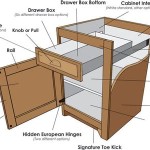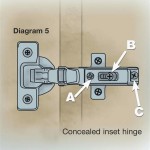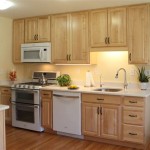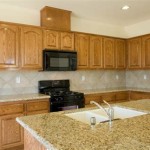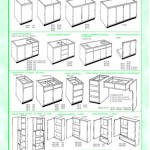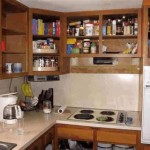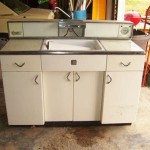How To Install Kitchen Cabinets On Uneven Walls
Installing kitchen cabinets against uneven walls presents a unique challenge. Achieving a professional, seamless look requires careful planning and execution. This article provides a step-by-step guide to navigating this process, ensuring a successful cabinet installation even with imperfect wall conditions.
Assessing the Walls
Before beginning the installation, a thorough assessment of the wall condition is crucial. This assessment informs the necessary adjustments and preparations required for a secure and aesthetically pleasing outcome.
- Identify the High and Low Spots: Use a long level or a straight edge held against the wall to pinpoint areas where the wall protrudes or recedes. Mark these areas clearly for reference.
- Measure the Extent of Unevenness: Quantify the deviations using a tape measure. These measurements will guide the shimming process later.
- Check for Plumb and Level: Ensure the walls are both plumb (vertically straight) and level (horizontally straight). Significant deviations will necessitate additional adjustments.
Preparing the Cabinets
Proper cabinet preparation ensures a smooth installation process and minimizes potential issues.
- Dry Fit the Cabinets: Temporarily position the cabinets against the wall to visualize the layout and identify potential fitting issues due to the unevenness. This step helps to preemptively address challenges.
- Reinforce Cabinet Structures (If Necessary): Depending on the cabinet construction and the extent of wall unevenness, consider reinforcing the cabinet backs with additional bracing for added stability.
Installing the First Cabinet
The installation of the first cabinet sets the standard for the rest of the process. Accuracy at this stage is paramount.
- Choose a Corner or Starting Point: Begin the installation with a corner cabinet or the cabinet that will anchor the rest of the layout. Typically, this will be the highest point on the floor.
- Shim the Cabinet: Place shims behind the cabinet to compensate for wall unevenness. Start with the largest gaps and work towards smaller adjustments. Use level and plumb tools frequently to maintain correct alignment.
- Secure the Cabinet: Once the cabinet is level and plumb, secure it to the wall studs using appropriate screws. Ensure the screws are driven firmly but avoid over-tightening, which could damage the cabinet.
Installing Subsequent Cabinets
With the first cabinet securely installed, the remaining cabinets are installed in a systematic manner, ensuring consistent alignment.
- Join Cabinets Together: Align and clamp adjacent cabinets, ensuring flush faces and consistent spacing. Use specialized cabinet clamps to maintain a tight joint while drilling pilot holes.
- Secure Cabinets to Each Other: Securely join the cabinets using screws through the pre-drilled pilot holes. This creates a unified structure that enhances stability.
- Shim as Needed: Continue to shim each cabinet as needed to maintain a level and plumb installation. Regular checks with a level and plumb tool are essential to ensure consistent alignment across all cabinets.
- Secure Cabinets to the Wall: Once a cabinet is level, plumb, and securely joined to its neighbor, secure it to the wall studs with appropriate length screws.
Finishing Touches
After all cabinets are installed, the final steps ensure a professional and polished look.
- Scribe and Fill Gaps: Use a scribe tool to accurately mark the profile of the uneven wall onto a filler strip. Cut the filler strip along the marked line and install it along the edges of the cabinets, creating a seamless transition between the cabinets and the wall.
- Caulk and Seal: Apply caulk along all seams and joints to seal against moisture and create a finished appearance.
Addressing Significant Wall Irregularities
In cases of severely uneven walls, more extensive measures may be necessary to ensure a successful cabinet installation.
- Furring Strips: Install furring strips, thin pieces of wood, to the wall, creating a new, even surface for cabinet attachment. These strips can be shimmed to compensate for large irregularities. This method offers more flexibility for extensive adjustments than shimming alone.
- Wall Repairs: For extremely uneven walls, consider professional wall repair or resurfacing to create a flatter surface before cabinet installation. While a bigger undertaking, this ensures a smoother process and a more stable end result.
Installing kitchen cabinets on uneven walls requires patience and precision. By following these steps, even DIY enthusiasts can achieve a professional-looking installation and enjoy a beautiful and functional kitchen.

Fitting Kitchen Units On Uneven Walls Has Never Been Easier

Fitting Cabinets To Bowed Walls

Cabinet Installation Plumb And Level Edgewood Cabinetry

Scribing In A Cabinet To Crooked Wall

Scribing Cabinets To An Uneven Wall
Install Base Cabinets On Uneven Wall Diy Home Improvement Forum

Fitting Kitchen Units On Uneven Walls Has Never Been Easier
Install Base Cabinets On Uneven Wall Diy Home Improvement Forum

Here S How Install New Upper Kitchen Cabinets

Tips To Get Ready For Kitchen Cabinet Installation
Related Posts

